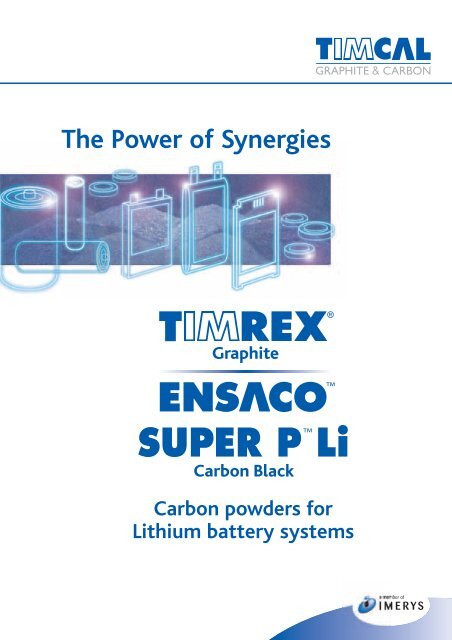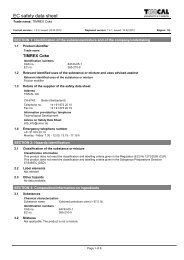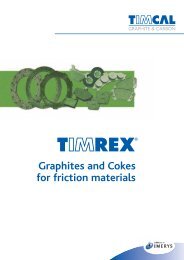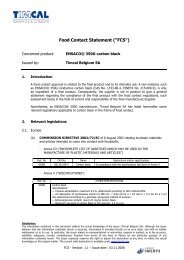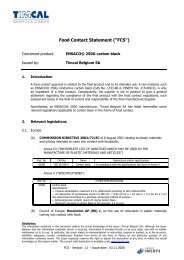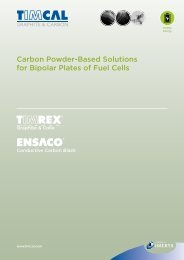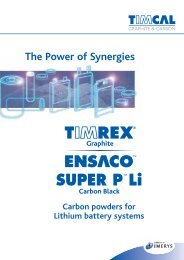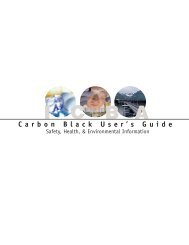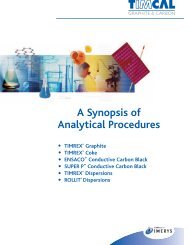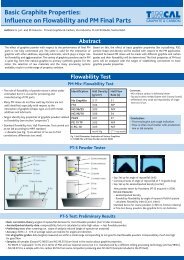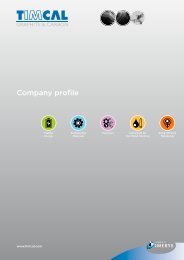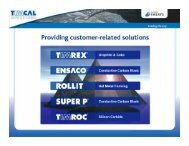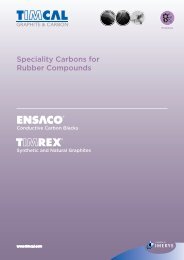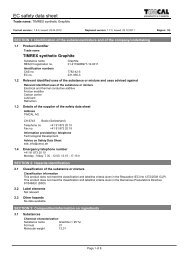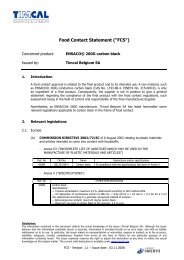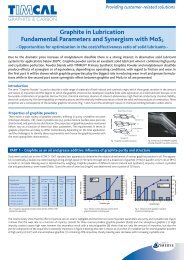SUPER P Li - Timcal Graphite
SUPER P Li - Timcal Graphite
SUPER P Li - Timcal Graphite
You also want an ePaper? Increase the reach of your titles
YUMPU automatically turns print PDFs into web optimized ePapers that Google loves.
The Power of Synergies<br />
<strong>Graphite</strong><br />
<strong>SUPER</strong> P <strong>Li</strong><br />
Carbon Black<br />
Carbon powders for<br />
<strong>Li</strong>thium battery systems
Who are we?<br />
NTIMCAL <strong>Graphite</strong> & Carbon has a<br />
strong tradition and history in carbon manufacturing.<br />
Its first manufacturing operation<br />
was founded in 1908.<br />
NToday, TIMCAL facilities produce and<br />
market a large variety of synthetic and natural<br />
graphite powders, conductive carbon<br />
black and dispersions of consistent high<br />
quality.<br />
NAdhering to a philosophy of Total Quality<br />
Management and continuous process<br />
improvement, the TIMCAL manufacturing<br />
plants comply with ISO 9001-2000.<br />
NTIMCAL <strong>Graphite</strong> & Carbon is committed<br />
to produce highly specialized graphite<br />
and carbon materials for today and tomorrow<br />
customers’ needs.<br />
NTIMCAL <strong>Graphite</strong> & Carbon is a member<br />
of IMERYS, a world leader in adding<br />
value to minerals.<br />
What is our vision?<br />
N<strong>Timcal</strong>’s vision is to be recognized worldwide<br />
as a leader in realizing challenging solutions<br />
for its customers by means of special<br />
carbons and related applications.<br />
What do we offer<br />
to our costumers?<br />
“Providing customer-related<br />
solutions”<br />
NTIMCAL <strong>Graphite</strong> & Carbon produces a<br />
variety of synthetic and natural graphite<br />
powders, conductive carbon blacks, calcined<br />
petroleum cokes, aqueous dispersions<br />
and silicon carbide with a common keyword:<br />
consistency. They are manufactured<br />
under stringent process control conditions<br />
from the raw material stage through the end<br />
product.<br />
NAdditionally, our team of specialists cooperates<br />
very closely with customers and<br />
research institutes to provide the very best<br />
advice and assist clients with today’s and<br />
tomorrow’s solutions.<br />
NFor further information, please contact<br />
our team who are ready to help you or visit<br />
our website: www.timcal.com.<br />
2<br />
www.timcal.com<br />
Where are we located?<br />
With headquarters in Switzerland, TIMCAL<br />
<strong>Graphite</strong> & Carbon has an international presence<br />
with facilities and commercial offices<br />
located in key markets around the Globe. The<br />
Group’s industrial and commercial activities<br />
are managed by an experienced multi-national<br />
team of more than 300 employees from<br />
many countries on three continents.<br />
Bodio, Switzerland<br />
Willebroek, Belgium<br />
Lac des Îles, Canada<br />
Terrebonne, Canada<br />
Changzhou, China<br />
Fuji, Japan<br />
Carbon powders<br />
for <strong>Li</strong>thium battery<br />
systems<br />
NThis document is intended to help our<br />
customers to make the best possible selection<br />
from the wide range of TIMCAL’s carbon<br />
additives available for the use in their<br />
lithium battery.<br />
NTIMCAL <strong>Graphite</strong> & Carbon offers a<br />
strong technical expertise to its existing and<br />
potential customers through its Marketing<br />
and Technological Groups. Our team of specialists<br />
has an extensive knowledge of carbon<br />
materials and corresponding application<br />
processes, as well as an excellent problemsolving<br />
record. Besides providing customer<br />
support, our experts work closely with the<br />
battery manufacturers to meet the growing<br />
challenges facing this industry.<br />
N<br />
The next pages will be devoted to the following<br />
topics:<br />
INTRODUCTION<br />
TO LITHIUM BATTERY....................pag. 3-4<br />
CARBON FOR SECONDARY<br />
LITHIUM BATTERY<br />
• Carbon materials as conductive<br />
additives.............................................pag. 5-6<br />
THE POSITIVE ELECTRODE<br />
• TIMCAL graphite and carbon black<br />
as conductive additives...................pag. 7-8<br />
THE NEGATIVE ELECTRODE<br />
• TIMCAL graphite and carbon black<br />
as conductive additives..................pag. 9-10<br />
CARBON FOR SECONDARY<br />
LITHIUM BATTERY<br />
• Carbon materials as electrochemically<br />
active material....................................pag. 11<br />
THE NEGATIVE ELECTRODE<br />
• TIMREX ® S-family as electrochemically<br />
active material.....................................pag. 12<br />
SELECTING THE APPROPRIATE<br />
CARBON FOR SECONDARY<br />
LITHIUM BATTERY......................pag. 13-14<br />
SELECTING THE APPROPRIATE<br />
CARBON FOR PRIMARY<br />
LITHIUM BATTERY.............................pag. 15
Introduction<br />
to the <strong>Li</strong>thium battery<br />
NThe proliferation of modern technologies,<br />
as well as the growing demand for unlimited<br />
mobility throughout society has created a<br />
boost in the demand for mobile energy storage<br />
systems and stimulated the phenomenal<br />
growth in the primary and rechargeable batteries<br />
industry. Portable electronic devices<br />
such as cellular phones, portable computers,<br />
video cameras and other consumer products<br />
require energy sources providing high energy<br />
and power density.<br />
NSustained demand for primary highpower<br />
battery has led to the development<br />
and production of the primary lithium battery.<br />
Similarly, strong market drive for a safe<br />
and high-energy rechargeable battery has<br />
allowed the fast development and market<br />
acceptance of the lithium-ion (<strong>Li</strong>-ion) battery<br />
technology.<br />
NIn addition, OEM manufacturers of stationary<br />
and automotive applications like<br />
hybrid electric vehicles, 42V-dual battery<br />
systems, as well as large sized batteries for<br />
telecommunications and space applications<br />
are intensively searching for battery technologies<br />
with improved energy and power<br />
density as well as an extended cycle life. In<br />
these areas, lithium-ion battery is being a<br />
serious candidate.<br />
NFor thermodynamic and kinetic reasons,<br />
lithium battery systems could meet the<br />
requirements for energy and power density<br />
for most battery applications in portable, stationary<br />
and traction (HEV and EV) equipment.<br />
Primary battery<br />
two to four times better than conventional<br />
primary alkaline batteries, flat discharge<br />
curve, shelf life exceeding 10 years and wide<br />
operating temperature range.<br />
NIn the positive electrode of primary lithium<br />
battery, carbon materials are mixed with<br />
active materials to provide the needed conductivity.<br />
Secondary battery<br />
NAs a material in the negative electrode,<br />
lithium metal is mainly used in primary battery<br />
systems, the reason being the limited<br />
rechargeability of metallic lithium for safety<br />
reasons.<br />
NThe substitution of lithium metal electrodes<br />
with insertion materials showing rela-<br />
N<strong>Li</strong>thium metal is attractive as a primary<br />
battery anode material because of its high<br />
specific capacity, high voltage, and good conductivity.<br />
Primary cells using lithium display<br />
superior performance such as high voltage of<br />
about 4 V, specific energy and energy density Secondary and primary batteries - energy density and specific energy<br />
tively high lithium activities initiated the<br />
break-through for the rechargeable lithium<br />
battery, the so-called <strong>Li</strong>thium-ion, Swing, or<br />
Rocking-Chair battery. The first <strong>Li</strong>-ion battery<br />
manufactured industrially appeared on<br />
the market in 1990.<br />
NSince then, this battery system enjoys a<br />
steady growth in demand compared with<br />
other rechargeable energy storage systems for<br />
the same fields of application. While offering<br />
remarkable safety, the <strong>Li</strong>-ion-system provides<br />
unique performance regarding high capacity,<br />
energy as well as power density, as the highly<br />
reactive lithium metal is bound in a carbonelectrode.<br />
N
NWhile optimizing the cell’s design, developers<br />
and researchers at the same time concentrated<br />
their attention on the improvement<br />
of the carbon negative electrode materials.<br />
In particular, graphitic carbons have<br />
become more and more attractive to be used<br />
as lithium insertion material. It was the<br />
progress in the carbon negative electrode<br />
materials, which has led to a major improvement<br />
of the lithium-ion batteries in terms of<br />
energy density. This has been achieved by<br />
replacing amorphous carbon by graphite<br />
materials, i.e. by increasing the crystallinity<br />
of the carbon negative electrode material.<br />
NA typical <strong>Li</strong>-ion-battery contains film electrodes<br />
of a thickness typically ranged from 40<br />
to 120 µm and arranged on metal foil current<br />
collectors.<br />
NIn the negative electrode carbon materials<br />
are used both as conductive agents and as<br />
electrochemically active materials. They are<br />
combined to binders and additives, and<br />
applied on a copper foil which acts as the current<br />
collector.<br />
NThe positive electrode consists of blends of<br />
a lithium metal oxide (cobalt, nickel or manganese<br />
oxide) with carbon black or/and<br />
graphite as conductive agent and a binder.<br />
Aluminium foils are commonly used as a<br />
current collector for the positive electrode.<br />
NThe separation of the electrodes is granted<br />
by an electrolyte, typically a lithium salt<br />
dissolved in an organic liquid carbonate<br />
soaked in a microporous polymer film.<br />
Solid ion-conducting polymers have been<br />
developed recently to be used as electrolytes<br />
in the so-called <strong>Li</strong>thium Polymer Batteries.<br />
NThe electrochemically active electrode<br />
materials in these batteries are similar to the<br />
conventional lithium-ion battery.<br />
NPolymer electrolytes allow the cell to<br />
become an “all-solid-state battery” offering<br />
a variety of completely new potentials<br />
regarding manufacturing technologies and<br />
cell designs.<br />
www.timcal.com<br />
Introduction<br />
to the <strong>Li</strong>thium battery<br />
4<br />
Improvement in energy density of <strong>Li</strong>-ion battery<br />
Rechargeable lithium-ion battery: arrangement of the film electrodes and schematic view of the galvanic cell
Carbon for secondary<br />
<strong>Li</strong>thium battery<br />
Carbon materials as conductive additives<br />
TITIMCAL <strong>Graphite</strong> & Carbon offers a<br />
large variety of carbon conductive additives<br />
that can be used in both the positive electrode<br />
and in the negative electrode of secondary<br />
lithium batteries. The chemical and physical<br />
properties, and the high purity of synthetic<br />
graphite and conductive carbon black make<br />
those carbon materials very suitable for secondary<br />
lithium batteries.<br />
Typical properties<br />
of carbon black and synthetic graphite<br />
Particle size<br />
BET (m 2 /g)<br />
Density (Kg/m3 ) 160 in bag<br />
Ash (%)<br />
Super P <strong>Li</strong> <strong>Graphite</strong> KS6<br />
40 nm (1)<br />
62<br />
0.01<br />
3 µm (2)<br />
20<br />
70 Scott (3)<br />
0.06<br />
(1)<br />
Average primary particle size from TEM pictures<br />
(2)<br />
D50 from laser diffraction.<br />
(3)<br />
Non-tapped<br />
Super P<strong>Li</strong> Purity of carbon black and synthetic graphite<br />
ppm<br />
<strong>Graphite</strong> KS6<br />
Al 1<br />
10<br />
Ca 8<br />
90<br />
Co < 0.1<br />
< 1<br />
Cr 2<br />
< 1<br />
Cu < 0.2<br />
< 1<br />
Fe 5<br />
75<br />
Mo 1<br />
< 1<br />
Ni 1<br />
2<br />
V<br />
0.2<br />
3<br />
TIConductive carbon black displays large<br />
surface area (50-770 m 2 /g) and high structure<br />
due to aggregation of nano-sized primary particles,<br />
while micro-sized graphite particles display<br />
moderate surface area (5-25 m 2 /g) and<br />
high anisotropy. The dimensions of the single<br />
crystal domains in the graphite particle are by<br />
more than a factor of ten larger than in a carbon<br />
black particle resulting in complementary<br />
properties.<br />
TEM Pictures of Super P <strong>Li</strong> and TIMREX ® graphite<br />
20 nm
www.timcal.com<br />
Carbon for secondary<br />
<strong>Li</strong>thium battery<br />
Carbon materials as conductive additives<br />
TIOn top of their purity and their physicochemical<br />
properties, TIMREX ® <strong>Graphite</strong><br />
and <strong>SUPER</strong> P <strong>Li</strong> / ENSACO carbon<br />
blacks display very favorable synergy as conductive<br />
additives in <strong>Li</strong>-ion electrodes due to<br />
complemetary effects in the electrodes.<br />
TISuch a synergy has been demonstrated in<br />
both the positive and the negative electrodes<br />
when TIMREX ® KS graphite has<br />
been mixed with <strong>SUPER</strong> P <strong>Li</strong> carbon<br />
black. Capacity retention during cycling<br />
and corresponding cycle life are significantly<br />
improved with this formulation based on<br />
<strong>Timcal</strong> carbon materials.<br />
Specific charge [mAh g -1 ]<br />
200<br />
160<br />
120<br />
80<br />
Cell parameters Carbon Black <strong>Graphite</strong><br />
Electrical conductivity<br />
of electrode<br />
Ionic electrode<br />
conductivity<br />
Energy density<br />
of the cell<br />
Electrode<br />
manufacturing<br />
process<br />
40 3 % Super P<br />
0<br />
0 20 40 60 80 100<br />
/ 2 % KS4<br />
5 % Super P <strong>Li</strong><br />
Particle-particle contact<br />
and contact to collector<br />
Electrolyte absorption<br />
Low amounts required<br />
Stable dispersions<br />
Binder compatibility<br />
<strong>Graphite</strong> and carbon black are complementary products<br />
Specific charge [mAh g -1 ]<br />
400<br />
300<br />
200<br />
100<br />
CARBON FUNCTIONS<br />
Cycle number Cycle number<br />
Conductive paths<br />
through electrode<br />
Porosity control<br />
Compressibility<br />
Low swelling<br />
Low binder amounts<br />
Low slurry viscosity<br />
<strong>Li</strong>CoO2 positive electrode <strong>Graphite</strong> negative electrode<br />
no additive<br />
8 % KS6/2 % Super P <strong>Li</strong><br />
4 % KS6/1 % Super P <strong>Li</strong><br />
0<br />
0 20 40 60 80 100<br />
Synergy of graphite and carbon black used as conductive additives blends in positive and negative electrodes<br />
TIMCAL <strong>Graphite</strong> & Carbon Black as conductive additives:<br />
The solution for the negative and positive electrodes in rechargeable lithium-ion batteries.<br />
6
Carbon for secondary<br />
<strong>Li</strong>thium battery: the positive electrode<br />
TIMCAL graphite and carbon black<br />
as conductive additives<br />
TIMCAL <strong>Graphite</strong> & Carbon offers a<br />
variety of carbon additives, which may be<br />
used in the positive electrode of secondary<br />
lithium batteries.<br />
Used in the positive electrode, they fulfill<br />
the following functions:<br />
They enhance the electrical conductivity<br />
at low or very low concentration.<br />
They ensure ideal contact between the<br />
electroactive oxide particles and the<br />
current collector as well as optimal<br />
inter-particle contacts.<br />
They control the electrode porosity for<br />
an optimized electrolyte access to the<br />
oxide particle.<br />
They do not interfere with the electrochemical<br />
mechanism.<br />
The following grades are suggested as conductive<br />
additives in the positive electrode of<br />
secondary lithium batteries:<br />
• <strong>Graphite</strong>:<br />
• TIMREX ® KS<br />
• TIMREX ® SFG<br />
• Carbon Black:<br />
• <strong>SUPER</strong> P <strong>Li</strong><br />
• ENSACO 250G<br />
• ENSACO 350G<br />
The choice of the optimal carbon or carbon<br />
blend gives you flexibility to adjust,<br />
besides the electrical conductivity, the electrolyte<br />
absorption properties and processrelated<br />
parameters like electrode slurry rheology<br />
and compressibility.<br />
TIMREX ® is also used as a coating on the<br />
aluminium current collector. This coating<br />
decreases the corrosion of the metal and<br />
lowers the contact resistance on the electrode/current<br />
collector surface.<br />
100 nm<br />
Pictures of TIMCAL graphites and carbon black<br />
suitable as conductive additives.<br />
Pict. 1: SEM Picture of TIMREX® SFG 15<br />
Pict. 2: SEM Picture of TIMREX® KS6<br />
Pict. 3: TEM Picture of Super P -<strong>Li</strong>
Resistivity (Ω cm)<br />
40<br />
35<br />
30<br />
25<br />
20<br />
15<br />
10<br />
5<br />
The electrical performance of selected dry<br />
electrode formulations shows that most of<br />
the formulations display a drastic drop in<br />
resistivity for carbon concentrations ranged<br />
from 2 to 6%, while they reach a stable resistivity<br />
at about 8%. The resistivities are<br />
reported for the dry electrodes and for the<br />
electrolyte soaked electrodes<br />
The graphs show the evolution of the positive<br />
electrode resitivity as a function of the<br />
carbon black concentration. The evolution is<br />
reported for three active materials: <strong>Li</strong>CoO 2,<br />
<strong>Li</strong>NiO 2 and <strong>Li</strong>Mn 2O 4, and three conductive<br />
additives: <strong>SUPER</strong> P <strong>Li</strong>, ENSACO 250G<br />
and ENSACO 350G.<br />
NIn general, where a carbon black gives a<br />
percolation threshold with a low concentration<br />
(%), the higher the structure and oil<br />
absorption number are.<br />
<strong>Li</strong>Mn2O4 percolation<br />
Carbon black concentration (%)<br />
www.timcal.com<br />
Carbon for secondary<br />
<strong>Li</strong>thium battery: the positive electrode<br />
TIMCAL graphite and carbon black<br />
as conductive additives<br />
0<br />
2 4 6 8 10 12 14 16<br />
8<br />
Resistivity (Ω cm)<br />
14<br />
12<br />
10<br />
8<br />
6<br />
4<br />
2<br />
<strong>Li</strong>CoO2 percolation<br />
0<br />
2 4 6 8 10 12 14 16<br />
Carbon black concentration (%)<br />
0<br />
2 4 6 8 10 12 14 16<br />
SuperP- <strong>Li</strong> SuperP- <strong>Li</strong>+electrolyte Ensaco 250 Ensaco 250+electrolyte Ensaco 350 Ensaco 350+electrolyte<br />
Resistivity (Ω cm)<br />
25<br />
20<br />
15<br />
10<br />
5<br />
<strong>Li</strong>NiO2 percolation<br />
Carbon black concentration (%)<br />
TIMCAL <strong>Graphite</strong> & Carbon Black as conductive additives:<br />
The solution for the positive electrodes in rechargeable lithium-ion batteries.
Carbon for secondary<br />
<strong>Li</strong>thium battery: the negative electrode<br />
TIMCAL graphite and carbon black<br />
as conductive additives<br />
The negative electrode containing low<br />
BET graphite as electrochemically active<br />
materials, often shows a relatively low electrical<br />
conductivity. The electrode resistivity is<br />
dependent on the intercalation host.<br />
High electrical conductivity is very important<br />
in the performance of the battery especially<br />
in the case of heavy discharge and<br />
charge abilities.<br />
Both, graphite and carbon black can be<br />
used as additives to enhance the electrical<br />
conductivity.<br />
NTIMCAL additives satisfy the following<br />
criteria:<br />
Increase conductivity at low<br />
concentration<br />
Increase electrode density<br />
Very limited interference with the<br />
intercalation and desintercalation<br />
mechanism<br />
- High purity (metal, sulphur)<br />
- No oversize contamination<br />
- No metallic particles<br />
Maintain conductivity of the electrode<br />
in the charged and uncharged states<br />
Low irreversible <strong>Li</strong> capacity<br />
No negative impact on electrode consistency<br />
and production process<br />
Control viscosity of the coating slurry<br />
NTIMCAL Group offers specially conditioned,<br />
tailor-made graphite materials for<br />
the negative electrode of the <strong>Li</strong>-ion cell.<br />
NThe selection of the tailor-made grade is a<br />
function of the negative electrode formulation,<br />
the process, and the expected performance.<br />
NTIMCAL negative electrode materials<br />
have optimised parameters which are<br />
expressed by an improved electrochemical<br />
performance in the battery.<br />
NDesigned, developed and optimised for<br />
this particular application, TIMREX ® SLP<br />
grades as well as other grades of the S-family<br />
have proven their performance in industrial<br />
use.<br />
NSuggested grades as conductive additive<br />
to the negative electrode:<br />
Press Density [g/cm 3]<br />
<strong>Graphite</strong>:<br />
• TIMREX ® SFG<br />
• TIMREX ® SLP<br />
Carbon Black:<br />
• <strong>SUPER</strong> P <strong>Li</strong><br />
• ENSACO 250G<br />
2.4<br />
2.0<br />
1.6<br />
1.2<br />
0.8<br />
graphite real density<br />
MCMB<br />
SFG15<br />
MCMB+20 % SFG15<br />
Pressure [Kg/cm2] 0 400 800 1200 1600<br />
Higher compressibility and optimized electrode density<br />
can be obtained by adding TIMREX® graphite to<br />
the negative electrode.<br />
<strong>Graphite</strong> parameters<br />
High crystallinity<br />
High xylene density<br />
High tap density<br />
High compressibility<br />
Optimized BET surface area<br />
Carbon black parameters<br />
High purity<br />
High structure<br />
High oil absorption
www.timcal.com<br />
Carbon for secondary<br />
<strong>Li</strong>thium battery: the negative electrode<br />
TIMCAL graphite and carbon black<br />
as conductive additives<br />
Highly crystalline graphite in the negative<br />
electrode mass can act as conductive additive<br />
and intercalation host (electrochemically<br />
active material). This double function makes<br />
therefore graphite addition very attractive.<br />
<strong>Graphite</strong> can act as host for lithium-ions,<br />
which are electrochemically intercalated<br />
between the graphite sheets. The reversibility<br />
of this process allows the multiple charge and<br />
discharge of the lithium graphite electrode.<br />
During the first electrochemical charge/discharge<br />
cycle of lithium-ion batteries using<br />
liquid or polymer electrolytes, an irreversible<br />
capacity is observed. Such an irreversible<br />
capacity has to be minimized in <strong>Li</strong>-ion battery<br />
electrode.<br />
In order to reduce such an irreversible<br />
capacity, graphite and carbon black should<br />
have additional features, such as low specific<br />
BET surface area, because surface area of carbon<br />
materials has been clearly associated<br />
with irreversible lithium capacity.<br />
Use of highly crystalline graphite as conductive<br />
additives allows electrodes containing<br />
low BET materials like MCMB or hard carbon<br />
coated graphites to obtain higher electrical<br />
performance and reversible capacity.<br />
10<br />
SLP50<br />
Irreversible and reversible capacities of the negative graphite electrode<br />
Influence of the BET surface area of the graphite negative electrode material on the irreversible capacity during<br />
the 1st. charge/discharge cycle of the <strong>Li</strong>thium-ion cell.<br />
TIMCAL <strong>Graphite</strong> & Carbon Black as conductive additives:<br />
The solution for the negative electrodes in rechargeable lithium-ion batteries.
Carbon for secondary<br />
<strong>Li</strong>thium battery<br />
Carbon materials as electrochemically active material<br />
NThe suitability of graphite and graphitic<br />
materials to be used as electroactive materials<br />
in the negative electrode of <strong>Li</strong>-ion-cells is<br />
granted by graphite’s ability to act as a host<br />
material to intercalate lithium between single<br />
graphite layers, forming lithium graphite<br />
intercalation compounds (<strong>Li</strong>-GlCs) up to<br />
<strong>Li</strong>C 6, which is equivalent to the theoretically<br />
achievable specific charge of 372 Ah per kg C.<br />
NThe crystal structure of graphite can be<br />
characterized as regular stacks of graphene<br />
sheets. Usually, polycrystalline graphite powder<br />
material is composed of the hexagonal<br />
graphite phase with rhombohedral defects. N<br />
TIMREX® graphite as lithium intercalation host<br />
NThe extent of rhombohedral defects is<br />
depending on the type of graphite as well as<br />
on its conditioning.<br />
NThe voltage steps observed in the discharge<br />
curve during the electrochemical intercalation<br />
of lithium (see curves on the previous page)<br />
are explained by the formation of the different<br />
existing <strong>Li</strong>-GlC’s until the final <strong>Li</strong>C 6 composition<br />
is reached. The reversibility of this<br />
process allows the multiple charge and discharge<br />
of the lithium graphite electrode.<br />
NDuring the first electrochemical charge/<br />
discharge cycle of lithium-ion batteries<br />
using liquid or polymer electrolytes, an irreversible<br />
capacity is observed. This capacity<br />
loss is due to the formation of the so-called<br />
Solid Electrolyte Interphase (SEI) which is<br />
an electronically insulating but ionically<br />
conductive passivation layer on individual<br />
graphite particle of the negative electrode.<br />
NThis SEI is essential for the further discharge/<br />
charge process as it prevents further<br />
electrolyte decomposition, but it means a<br />
charge loss in the cell. Furthermore, an<br />
optimized SEI may increase the thermal<br />
safety of a <strong>Li</strong>-ion cell drastically.<br />
NElectrochemical measurements with electrodes<br />
containing different TIMREX ®<br />
graphites show a linear relationship between<br />
the irreversible capacity and BET surface<br />
area as well as double layer capacitance.<br />
These relationships then demonstrate that<br />
surface of mesopores in synthetic and natural<br />
graphites are wetted by the cell electrolyte,<br />
thus contributing to the irreversible capacity<br />
of the <strong>Li</strong>-ion cell.
Carbon for secondary<br />
<strong>Li</strong>thium battery: the negative electrode<br />
TIMREX ® S-family as electrochemically active material<br />
TIMREX ® SLP<br />
Potato ® -Shape<br />
<strong>Graphite</strong> Family<br />
TIMCAL’s know-how in the field of synthetic<br />
and natural graphite, materials science,<br />
and electrochemistry made possible<br />
the development of the new S-family of<br />
high-performance graphite.<br />
The TIMREX ® SLP-grades, produced<br />
through a proprietary process by TIMCAL<br />
(filed PCT), are the first members of the<br />
new Potato ® -Shape <strong>Graphite</strong> family, which<br />
are used as a main component in the negative<br />
electrode,<br />
especially in combination with <strong>Li</strong> (Nix Coy<br />
Mnz) O2 positive electrode materials. They<br />
may also be used in blends with other<br />
active carbon electrode materials in<br />
<strong>Li</strong>CoO2 containing batteries.<br />
The highly crystalline structure of TIM-<br />
REX ® SLP graphite ensures high reversible<br />
specific charge, low irreversible capacity<br />
and improved cycling stability. This, in<br />
turn, makes it possible to reach the energy<br />
density and power density expected from<br />
modern lithium-ion batteries.<br />
Thanks to the unique texture and morphology<br />
of the round-shaped particles, TIM-<br />
REX ® SLP graphite has a higher apparent<br />
density and compressibility, which leads to a<br />
higher density and more ideal porosity of the<br />
negative electrode.<br />
Due to the special proprietary treatment,<br />
TIMREX ® SLP graphite exhibits very low oil<br />
absorption, a unique property for such highly<br />
crystalline graphite. This indicates optimal<br />
binder absorption properties, which enhance<br />
the adhesion of the negative electrode to the<br />
copper current collector and improve the<br />
overall mechanical stability of the negative<br />
electrode.<br />
12<br />
www.timcal.com<br />
TIMREX ® SLP 30 and SLP 50 are therefore<br />
ideal solutions for the negative electrode.<br />
They are highly crystalline synthetic<br />
graphites for negative electrodes that display<br />
high reversible capacity under existing conditions<br />
prevailing in <strong>Li</strong>-ion batteries. Our group<br />
of experts is also developing other innovative<br />
and high performance carbon materials to<br />
enlarge our S-family of electrochemically<br />
active graphite for <strong>Li</strong>-ion batteries.<br />
This development is being done by working<br />
very closely with our customers. Please contact<br />
us if you want to be part of this program<br />
and to get access to the newest materials (see<br />
back of brochure for contact details).<br />
10 µm<br />
SEM picture of a TIMCAL tailor-made graphite especially<br />
optimized as negative electrode material<br />
Scott density [g/cm 3 ]<br />
DBP absorption [g DBP/100g C]<br />
0.40<br />
0.35<br />
0.30<br />
0.25<br />
0.20<br />
0.15<br />
0.10<br />
0.05<br />
0.00<br />
120<br />
80<br />
40<br />
0<br />
Density of TIMREX® <strong>Graphite</strong>s<br />
KS44<br />
SFG44<br />
SLP50<br />
KS44 SFG44 SLP50<br />
SLP30<br />
Oil absorption of TIMREX® <strong>Graphite</strong>s<br />
SLP30
Selecting<br />
the appropriate carbon<br />
for secondary <strong>Li</strong>thium battery<br />
<strong>Graphite</strong> grades<br />
NTIMREX ® KS grades are the synthetic<br />
graphites mostly used as conductive additives<br />
in the positive electrode. They have relatively<br />
small single crystal domains in the particle,<br />
resulting in a relatively high isotropic electrical<br />
conductivity.<br />
NFurthermore, they offer excellent electrolyte<br />
absorption capacity due to their<br />
unique pore structure, as well as outstanding<br />
tribological properties. Their isometric particle<br />
shape causes relatively low DBP oil<br />
adsorption values, a reason for the excellent<br />
processability and rheological behavior of KS<br />
graphites in liquid coating dispersions.<br />
NTIMREX ® SFG graphite grades are synthetic<br />
flake graphites with a highly anisometric<br />
particle shape. Large single crystal<br />
domains with high La and Lc values are<br />
aligned in the graphite particle, resulting in<br />
highly anisotropic material properties. Due to<br />
this texture and crystallinity, these grades<br />
show lowest specific surface area and highest<br />
electronical conductivity of all synthetic<br />
TIMREX ® graphites.<br />
NTIMREX ® SLP grades, produced through<br />
a process patented by TIMCAL, are used as<br />
main component of the negative elec-<br />
trode especially in combination with<br />
<strong>Li</strong> (NixCoyMnaz)O2 positive electrode materials.<br />
Their highly crystalline structure<br />
ensures high reversible charge, low irreversible<br />
capacity, and improved cycling stability.<br />
TIMCAL graphite in the negative electrode. Typical values and recommended application<br />
<strong>Graphite</strong><br />
grade<br />
SLP30<br />
SLP50<br />
SFG6<br />
SFG10<br />
SFG15<br />
SFG44<br />
TIMCAL graphite in the positive electrode. Typical values and recommended application<br />
<strong>Graphite</strong><br />
grade<br />
KS4<br />
KS6<br />
KS10<br />
KS15<br />
SFG6<br />
SFG10<br />
SFG15<br />
Particle size<br />
d 90 (µm)<br />
32<br />
45<br />
6,5<br />
12,8<br />
17,9<br />
48,8<br />
Particle size<br />
d 90 (µm)<br />
4,7<br />
6,5<br />
12,5<br />
17.2<br />
6,5<br />
12,8<br />
17,9<br />
Particle<br />
shape<br />
Potato® Shape<br />
Potato® Shape<br />
Highly anisometric<br />
flakes<br />
Highly anisometric<br />
flakes<br />
Highly anisometric<br />
flakes<br />
Highly anisometric<br />
flakes<br />
Particle<br />
shape<br />
Isometric, irregular<br />
spheroids<br />
Isometric, irregular<br />
spheroids<br />
Isometric, irregular<br />
spheroids<br />
Isometric, irregular<br />
spheroids<br />
Highly anisometric<br />
flakes<br />
Highly anisometric<br />
flakes<br />
Highly anisometric<br />
flakes<br />
Ash<br />
(%)<br />
0,06<br />
0,06<br />
0,07<br />
0,07<br />
0,07<br />
0,07<br />
DBP Scott density<br />
(g/100g) (g/m3 )<br />
190<br />
170<br />
160<br />
140<br />
180<br />
170<br />
150<br />
Scott density<br />
(g/m 3 )<br />
0,32<br />
0,40<br />
0,07<br />
0,07<br />
0,09<br />
0,19<br />
0,07<br />
0,07<br />
0,09<br />
0,10<br />
0,07<br />
0,07<br />
0,09<br />
Specific BET<br />
surface area<br />
(m 2 /g)<br />
7<br />
6<br />
17<br />
12<br />
9<br />
5<br />
Specific BET<br />
surface area<br />
(m 2 /g)<br />
26<br />
20<br />
16<br />
12<br />
17<br />
12<br />
9<br />
Recommended<br />
application and<br />
concentration<br />
Intercalation agent standalone<br />
or mix-in up to 50%<br />
Intercalation agent standalone<br />
or mix-in up to 50%<br />
Conductive additive,<br />
10-20%<br />
Conductive additive,<br />
10-20%<br />
Conductive additive,<br />
10-20%<br />
Conductive additive,<br />
10-25%<br />
Recommended<br />
application and<br />
concentration<br />
Conductive additive,<br />
up to 10%<br />
Conductive additive,<br />
up to 10%<br />
Conductive additive,<br />
up to 10%<br />
Conductive additive,<br />
up to 10%<br />
Conductive additive,<br />
up to 10%<br />
Conductive additive,<br />
up to 10%<br />
Conductive additive,<br />
up to 10%
Selecting<br />
the appropriate carbon<br />
for secondary <strong>Li</strong>thium battery<br />
Carbon black grades<br />
NThe low impurity levels of carbon black<br />
required by the lithium battery technology is<br />
achieved by the TIMCAL process, thanks to<br />
the absence of quenching gas, the highly pure<br />
feedstock, and the unique design and control.<br />
For an optimal performance of the electrochemical<br />
cell, the nature and concentration of<br />
carbon black in the positive and negative electrode<br />
play an important role. The selection of<br />
the optimum carbon black grade and amount<br />
requires a balance between several performance<br />
parameters.<br />
N<strong>SUPER</strong> P <strong>Li</strong> is a superior performing conductive<br />
additive to the cathode and anode<br />
mixes with possible positive impact on the<br />
cyclability of the battery.<br />
NENSACO 250G has comparable performance<br />
to <strong>SUPER</strong> P <strong>Li</strong> but a noticeable<br />
advantage in handling, due to its granular<br />
form.<br />
The use of ENSACO 350 G even allows<br />
the reduction of the carbon content, and as<br />
such, a higher active material concentration.<br />
14<br />
www.timcal.com<br />
NMixtures of graphite and carbon black can<br />
be used for the conductive matrix, as they fulfil<br />
complementary electrical functions. Carbon<br />
black improves the contact between the particles<br />
of active material, while graphite creates<br />
the conductive path through the electrode.<br />
Positive effects of binary mixtures such<br />
as TIMREX ® KS6 and <strong>SUPER</strong> P <strong>Li</strong>,<br />
TIMREX ® SFG6 and ENSACO 250P have<br />
been already demonstrated.<br />
TIMCAL carbon black in the negative and/or positive electrode.<br />
Typical values and recommended application<br />
Super P-<strong>Li</strong> Ensaco 250G<br />
Ensaco 260G<br />
Ensaco Carbon Black<br />
grade<br />
Sulphur<br />
content<br />
(ppm)<br />
Oil absorption<br />
number/absorption<br />
stiffness<br />
Density ASTM<br />
D1513-89<br />
(gr/cm<br />
350G<br />
3 )<br />
Specific BET<br />
surface area<br />
(m2 /g)<br />
Physical<br />
form<br />
50-100 290/32<br />
n.a. 62 Powder<br />
50-100 190/18<br />
170 65 Granules<br />
50-100<br />
190/18<br />
170 70 Granules<br />
50-100<br />
320/55<br />
135 770 Granules<br />
Recommended<br />
application<br />
and concentration<br />
conductive additive, 3-6%<br />
conductive additive, 3-6%<br />
conductive additive, 2-5%<br />
conductive additive,1-3%
Selecting<br />
the appropriate carbon<br />
for primary <strong>Li</strong>thium battery<br />
TIMCAL <strong>Graphite</strong> & Carbon offers a<br />
variety of carbon additives, which may be<br />
used in the positive electrode of primary<br />
lithium batteries. These additives are actually<br />
quite similar to those currently used in the<br />
positive electrode of secondary lithium batteries.<br />
Used in the positive electrode, they<br />
basically fulfil the same functions in primary<br />
as in secondary lithium batteries.<br />
The following grades are suggested as conductive<br />
additives in the positive electrode of<br />
primary lithium battery:<br />
<strong>Graphite</strong>:<br />
• TIMREX ® KS<br />
Carbon Black:<br />
• <strong>SUPER</strong> P <strong>Li</strong><br />
TIMCAL graphite in the positive electrode<br />
Grade<br />
KS6<br />
KS15<br />
Grade Sulphur<br />
content<br />
(ppm)<br />
Super P-<strong>Li</strong><br />
Particle size<br />
d 90 (µm)<br />
6,5<br />
17,2<br />
Particle<br />
shape<br />
Isometric, irregular,<br />
spheroids<br />
Isometric, irregular,<br />
spheroids<br />
Oil absorption<br />
number/absorption<br />
stiffness (1)<br />
Ash<br />
(%)<br />
0,06<br />
0,05<br />
TIMCAL carbon black in the positive electrode<br />
Scott density<br />
(g/m 3 )<br />
0,07<br />
0,10<br />
Specific BET<br />
surface area<br />
(m 2 /g)<br />
Specific BET<br />
surface area<br />
(m 2 /g)<br />
Physical<br />
form<br />
50-100 290/32 62 Powder<br />
(1) Oil absorption number in mL/100g and absorption stiffness in mL/5g<br />
The choice of the optimal carbon or carbon<br />
blend gives an appreciable flexibility to<br />
adjust, besides the electrical conductivity,<br />
the electrolyte absorption properties and<br />
process-related parameters.<br />
TIMREX ® KS grades or/and <strong>SUPER</strong> P <strong>Li</strong><br />
are the carbon materials commonly used as<br />
conductive additives in the positive electrode.<br />
Their properties reveal high purity,<br />
controlled size distribution, surface area and<br />
absorption that make these materials very<br />
effective conductive additives.<br />
20<br />
12<br />
Recommended<br />
application and<br />
concentration<br />
Conductive additive,<br />
up to 10%<br />
Conductive additive,<br />
up to 10%<br />
Recommended<br />
application and<br />
concentration<br />
Conductive additive,<br />
3-6%
Commercial Offices<br />
Manufacturing Plants<br />
Distributors / Agents<br />
(full list available on request)<br />
Offered by:<br />
© 2005 TIMCAL Ltd., CH-Bodio<br />
No part of this publication may be reproduced in<br />
any form without the prior written authorisation<br />
of TIMCAL Ltd.<br />
Printed in Switzerland.<br />
Leading the way.<br />
TIMCAL Ltd.<br />
Group Head Office<br />
CH-6743 Bodio<br />
Switzerland<br />
Phone: +41 91 873 20 10<br />
Fax: +41 91 873 20 19<br />
info@ch.timcal.com<br />
TIMCAL America Inc.<br />
29299 Clemens Road 1-L<br />
Westlake, Ohio 44145<br />
USA<br />
Phone: +1 440 871 7504<br />
Fax: +1 440 871 6026<br />
info@us.timcal.com<br />
TIMCAL Japan K.K.<br />
7F Sagamiya Bldg.<br />
6 Ichibancho Chiyoda-ku<br />
Tokyo 102-0082 Japan<br />
Phone: +81 3 3511 2078<br />
Fax: +81 3 3511 2077<br />
info@jp.timcal.com<br />
TIMCAL France<br />
Representative Office<br />
154-156 rue de l’Université<br />
F-75007 Paris France<br />
Phone: +33 1 49 55 65 90/91<br />
Fax: +33 1 49 55 65 95<br />
info@fr.timcal.com<br />
TIMCAL Deutschland GmbH<br />
Representative Office<br />
Berliner Allee 47<br />
DE-40212, Düsseldorf<br />
Germany<br />
Phone: +49 (0)211 130 667-0<br />
Fax: +49 (0)211 130 667-13<br />
info@de.timcal.com<br />
Changzhou TIMCAL<br />
<strong>Graphite</strong> Corp. Ltd.<br />
188# Taishan Road,<br />
Hi-Tech Zone<br />
Changzhou 213022 P.R. China<br />
Phone: +86 519 5100801<br />
Fax: +86 519 5101322<br />
info@cn.timcal.com<br />
TIMCAL Canada Inc.<br />
990 rue Fernand-Poitras<br />
Terrebonne (Québec)<br />
Canada J6Y 1V1<br />
Phone: +1 450 622 9191<br />
Fax: +1 450 622 8692<br />
info@ca.timcal.com<br />
TIMCAL Belgium N.V/S.A<br />
Appeldonkstraat 173<br />
BE-2830 Willebroek<br />
Belgium<br />
Phone: +32 3 886 71 81<br />
Fax:+32 3 886 47 73<br />
info@be.timcal.com<br />
<strong>Timcal</strong> UK<br />
Representative Office<br />
PO Box 269, Congleton<br />
CW123WP, England<br />
Phone: +44 (0) 1260 276009<br />
Fax: +44 (0) 1260 289057<br />
info@uk.timcal.com<br />
LITH. 06.2005


